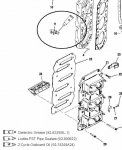hkeiner
Lieutenant Junior Grade
- Joined
- Oct 17, 2006
- Messages
- 1,055
I want to replace the Thermal Air Valve on my motor. This valve closes (shuts off) some of the air flowing to the idle circuit when the motor is cold (resulting in a richer fuel/air mixture) and then opens when the motor warms up. The valve is screwed into the starboard cylinder head and an air hose runs from the valve to the idle circuits on the carbs.
I figure that this is an easy replacement job but want to be sure about the use of dielectric grease during installation of the valve. The Mercury shop manual does not have any detail instructions on the removal/installation of this valve although the parts diagram does seem to indicate that (#6) dielectric grease should be applied to the valve before installation. This seems to be an unusual use for dielectric grease. I have always used it previously only for protecting electrical connections.
In an attempt to become more knowledgeable about outboard motor maintenance and repair matters , I have the following questions:
1) If the purpose of the dielectric grease is to keep the valve from getting seized over time, why wouldn't anti-seize compund be used?
2) If the purpose of the dielectric grease is to improve thermal transfer from the cylinder head to the valve, why wouldn't thermal grease be used?
3) Should the dielectric grease be applied evenly over the entire thread of the valve or only at the top edge of the threads (where the treads are near the exterior edge of the cylider head).
4) What amount of torque should be used to tighten the valve. If there is no specific torque value known (i.e., Newton Meter), should it be "tight" or "really tight"?
Thanks in advance for any information/tips on this.




















